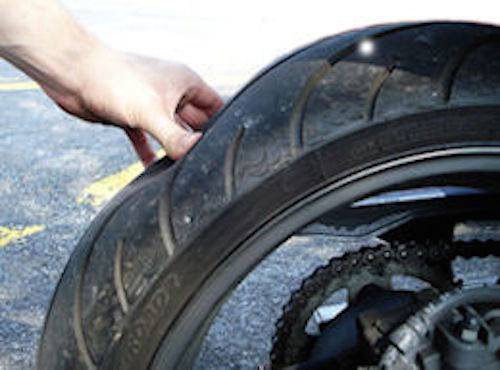How to fix a puncture
Pffffffff... What next?

By Alan Dowds
UNLESS you ride a 1960s Italian scooter with a spare wheel bolted onto the front, a puncture on a bike is, on the face of it, a proper ball-ache. Your tyres are the key to your progress on the roads, and with a hole in one, you're going nowhere fast.
But there are answers. Compact puncture repair kits can be stuck under your seat, and, nine times out of ten, will get you back up and running again – at least far enough to get home, or to a garage or bike shop. Here’s our guide to defeating deflations…
Plug kit
A straightforward hole in the tread of your tyre can be fixed roadside with one of the many plug kits. These vary in detail, but the principle is the same: stuff a rubber or plastic plug into the hole, and it'll seal the hole. Some plugs incorporate a bonding agent which 'glues' them into the hole, some you spread with a rubber solution glue, some use a mechanical locking method. The technique is simple: remove anything still in the hole in the tyre, use a supplied tool to open up and roughen the hole (ooh-er), then use another tool to push the plug into the puncture. Done.
These kits usually come with small CO2 canisters, and a valve adapter, to inflate the tyre afterwards. There's never enough gas in them, so try and pack some extras. If you have a bike with lots of luggage space, consider packing a small electric or foot pump for long trips.
Aerosol
In theory, an aerosol puncture repair kit is the easiest solution. A can of pressurised gas and sticky foam is sprayed inside the tyre through the valve, and it seals the hole and inflates the tyre in one. Holts Tyreweld and the like work well on small punctures, and we've used them plenty of times over the years. The problem comes when you want to get the tyre professionally repaired: the gunge inside the tyre is a pain to clean out, and some garages will be reluctant to repair a tyre that's been patched up with this method.
Tubed tyre
We’ve all fixed punctures on our pedal bikes as kids, so fixing an inner tube on a bike should be a breeze, right? Well, yes and no. Fixing the tube itself is easy enough with a special vulcanised patch and rubber solution, but you have to get to the facking thing. Wheel off, and/or tyre levered off one side, finding the hole, it's all grief on a big bike at the side of the road. A spare tube helps a bit, but you still need to get access.
If you're determined, make sure you have all the tools you'll need under the seat, and practice getting the wheel and tyre on and off.
Professional fix
The best repair is a proper internal patch or plug, fitted from the inner side of the tyre, and vulcanised into the carcass. Should only be done in the main body of the tread, in the centre of the tyre, and you shouldn't really do more than one repair.
Damage to the sidewall can't be repaired by any method, and holes here mean a scrap tyre.
Puncture prevention?
Some folk swear by gunk that you pour inside the tyre which seals punctures as they happen, so you never know about it. No-one seriously recommends these – the major gripe being that they can mask serious tyre damage until a catastrophic failure. Avoid, is our advice.
The best puncture prevention is to look after your tyres to start with, and replace them well before they get to the legal limit. Worn tyres are more easily holed by screws or nails, and we've always had more punctures on old, thinner rubber than new hoops. Keep the pressures right, inspect regularly for any damage, and keep your emergency repair kit in good order too.











